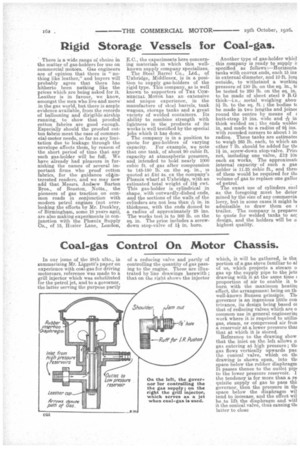Coal-gas Control On Motor Chassis.
Page 12

If you've noticed an error in this article please click here to report it so we can fix it.
In our issue of the 28th alto., in summarizing Mr. Liggett's paper on experience with coal-gas for driving motorcars, reference was made to a grill injector which was substituted for the petrol jet, and to a governor, the latter serving the purpose partly of a reducing valve and partly of controlling the quantity of gas passing to the engine. These are illustrated by line drawings herewith ; that on the right shows the injector which, it will be gathered, is tha portion of a gas stove familiar to al of us, which projects a stream o gas up the supply pipe to the jets drawing with it e,-t, the same time 4 proportion of air to enable it t( burn with the maximum heating effect, the arrangement being on tho well-known Bunsen principle. nu governor is an ingenious little con trivance, its design being based co that of reducing valves which are o common use in general engineering work where it is required to utiliz( gas, steam, or compressed air fron a reservoir at a lower pressure thai that at which it is stored.
Reference to the drawing show that the inlet on the left allows o gas entering at high pressure ; tie gas flows vertically upwards pas the conical valve, which on thl drawing is shown open, into th( space below the rubber diaphragm It passes thence to the outlet pip( to the lower pressure reservoir. I the tendency is for more than a re quisite supply of gas to pass thy governor, then the pressure in thi space below the diaphragm wil tend to increase, and the effect wil be the lift the diaphragm and witl it the conical valve, thus causing thl latter to close






















